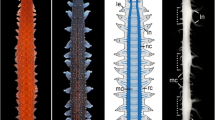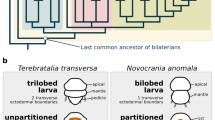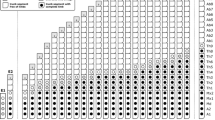Summary
We have examined the embryo of the centipedeEthmostigmus rubripes to determine the degree of evolutionary conservatism in the developmental processes of segmentation, neurogenesis and axon formation between the insects and the myriapods. A conspicuous feature of centipede embryogenesis is the early separation of the left and right sides of the ganglionic primordia by extra-embryonic ectoderm. An antibody to the protein encoded by theDrosophila segmentation geneengrailed binds to cells in the posterior margin of the limb buds in the centipede embryo, in common with insect and crustacean embryos. However, whereas in insects and crustaceans this protein is also expressed in a subset of cells in the neuroectoderm, the anti-engrailed antibody did not bind to cells in the ganglionic primordia of the centipede embryo. Use of the BrdU labelling technique to mark mitotically active cells revealed that neuroblasts, the ubiquitous neuron stem cell type in insects, are not present in the centipede. The earliest central axon pathways in the centipede embryo do not arise from segmentally repeated neurons, as is the case in insects, but rather by the posteriorly directed growth of axons originating from neurons located in the brain. Axonogenesis by segmental neurons begins later in development; the pattern of neurons involved is not obviously homologous to the conservative set of central pioneering neurons found in insects. Our observations point to considerable differences between the insects and the myriapods in mechanisms for neurogenesis and the formation of central axon pathways, suggesting that these developmental processes have not been strongly conserved during arthropod evolution.
Similar content being viewed by others
References
Akam M, Dawson I, Tear G (1988) Homeotic genes and the control of segment diversity. Development 104: [Suppl] 123–133
Anderson D (1973)Embryology and Phylogeny in Annelids and Arthropods. Pergamon Press, Oxford
Beeman RW (1987) A homeotic gene cluster in the red flour beetle. Nature, Lond 327:247–249
Bodmer R, Jan YN (1987) Morphological differentiation of the embryonic peripheral neurons inDrosophila. Roux's Arch Dev Biol 196:69–77
Campos-Ortega JA, Hartenstein V (1985)The Embryonic Development of Drosophila melanogaster. Springer, Berlin Heidelberg New York Tokyo
Carr JN, Taghert PH (1988) Formation of the transverse nerve in moth embryos. I. A scaffold of nonneuronal cells prefigures the nerve. Dev Biol 130:487–499
Denburg JL, Fülöp Z (1982) Formation of the leg neuro-muscular system in embryos of the cockroach,Periplaneta americana. I. Light microscopic studies. J Exp Zool 219:323–338
Doe CQ, Goodman CS (1985) Early events in insect neurogenesis. I. Developmental and segmental differences in the pattern of neuronal precursor cells. Dev Biol 111:193–205
Dohle W (1964) Die Embryonalentwicklung vonGlomeris marginata (Villiers) im Vergleich zur Entwicklung anderer Diplopoden. Zool Jb Anat Ont 81:241–310
Field KG, Olsen GJ, Lane DJ, Giovanni SJ, Ghiselin MT, Raff EC, Pace NR, Raff RA (1988) Molecular phylogeny of the animal kingdom. Science 239:748–753
French V, Ingham P, Cooke J, Smith J (1988)Mechanisms of Segmentation. Development [Suppl] 104
Goodman CS, Bastiani MJ, Doe CQ, du Lac S, Helfand SL, Kuwada JY, Thomas JB (1984) Cell recognition during neuronal development. Science 225:1271–1279
Gratzner HG (1982) Monoclonal antibody to 5-bromo and 5-iododeoxyuridine: a new reagent for detection of DNA replication. Science 218:474–475
Hartenstein V (1988) Development ofDrosophila larval sensory organs: spatiotemporal pattern of sensory neurones, peripheral axon pathways and sensilla differentiation. Development 102:869–886
Heathcote FG (1886) The early development ofJulus terrestris. QJ Microsc Sci 26:449–470
Hertzel G (1984) Die Segmentation des Keimstreifens vonLithobius forficatus (L.) (Myriapoda, Chilopoda). Zool Jb Anat 112:369–386
Heymons R (1901) Die Entwicklungsgeschichte der Scolopender. Zoologica 13:1–224
Jan LY, Jan YN (1982) Antibodies to horseradish peroxidase as specific neuronal markers inDrosophila and grasshopper embryos. Proc Natl Acad Sci USA 79:2700–2704
Knoll HJ (1974) Untersuchungen zur Entwicklungsgeschichte vonScutigera coleoptrata L. (Chilopoda). Zool Jb Anat 92:47–132
Manton S (1972) The evolution of arthropod locomotory mechanisms, Part 10. J Linn Soc Zool 51:203–400
Meier T, Reichert H (1990a) Embyonic development and evolutionary origin of the orthopteran auditory organs. J Neurobiol 21:592–610
Meier T, Reichert H (1990b) Neuronal development in the crustacean nervous system studied by neuron-specific antibody labelling. In: Wiese K, Krenz W, Tautz J, Reichert H, Mulloney B (eds) Frontiers in crustacean neurobiology. Birkäuser Verlag, Basel, pp 523–529
Patel NH, Martin-Blanco E, Coleman KG, Poole SJ, Ellis MC, Kornberg TB, Goodman CS (1989a) Expression ofengrailed proteins in arthropods, annelids and chordates. Cell 58:955–968
Patel NH, Kornberg TB, Goodman CS (1989b) Expression ofengrailed during segmentation in grasshopper and crayfish. Development 107:201–212
Raff R, Kaufman T (1983) Embryos, Genes and Evolution. MacMillan, New York
Raper JA, Bastiani MJ, Goodman CS (1983) Pathfinding by neuronal growth cones in grasshopper embryos. I Divergent choices made by the growth cones of sibling neurons. J Neurosci 3:20–30
Sander K (1988) Studies on insect segmentation: from teratology to phenogenetics. Development [Suppl] 104:112–121
Schubiger M, Palka J (1987) Changing spatial patterns of DNA replication in the developing wing ofDrosophila melanogaster. Dev Biol 123:145–153
Shepherd D, Bate CM (1990) Spatial and temporal patterns of neurogenesis in the embryo of the locust (Schistocerca gregaria). Development 108:83–96
Thomas JB, Bastiani MJ, Bate M, Goodman CS (1984) From grasshopper toDrosophila: a common plan for neuronal development. Nature 310:203–207
Tiegs OW (1940) The embryology and affinities of the Symphyla, based on a study ofHanseniella agilis. QJ Microscop Sci 82:1–225
Tiegs OW (1947) The development and affinities of the Pauropoda, based on a study ofPauropus sylvaticus. QJ Microsc Sci 88:165–267/175-336
Truman JW, Bate M (1988) Spatial and temporal patterns of neurogenesis in the central nervous system ofDrosophila melanogaster. Dev Biol 125:145–157
Author information
Authors and Affiliations
Rights and permissions
About this article
Cite this article
Whitington, P.M., Meier, T. & King, P. Segmentation, neurogenesis and formation of early axonal pathways in the centipede,Ethmostigmus rubripes (Brandt). Roux's Arch Dev Biol 199, 349–363 (1991). https://doi.org/10.1007/BF01705928
Received:
Accepted:
Issue Date:
DOI: https://doi.org/10.1007/BF01705928




